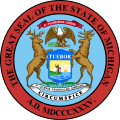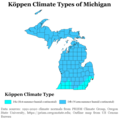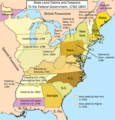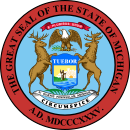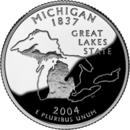Portal:Michigan
The Michigan Portal  Michigan (/ˈmɪʃɪɡən/ MISH-ig-ən) is a state in the Great Lakes region of the Upper Midwest region of the United States. It borders Wisconsin to the northwest in the Upper Peninsula, and Indiana and Ohio to the south in the Lower Peninsula; it is also connected by Lakes Superior, Michigan, Huron, and Erie to Minnesota and Illinois, and the Canadian province of Ontario. With a population of nearly 10.12 million and an area of 96,716 sq mi (250,490 km2), Michigan is the 10th-largest state by population, the 11th-largest by area, and the largest by area east of the Mississippi River. Its capital is Lansing, and its largest city is Detroit. Metro Detroit is among the nation's most populous and largest metropolitan economies. The name derives from a gallicized variant of the original Ojibwe word ᒥᓯᑲᒥ (mishigami), meaning "large water" or "large lake". Michigan consists of two peninsulas. The Lower Peninsula resembles the shape of a mitten, and comprises a majority of the state's land area. The Upper Peninsula (often called "the U.P.") is separated from the Lower Peninsula by the Straits of Mackinac, a five-mile (8 km) channel that joins Lake Huron to Lake Michigan. The Mackinac Bridge connects the peninsulas. Michigan has the longest freshwater coastline of any political subdivision in the United States, being bordered by four of the five Great Lakes and Lake St. Clair. It also has 64,980 inland lakes and ponds. Michigan has the second-most water area of any state, behind only Alaska. The area was first occupied by a succession of Native American tribes over thousands of years. In the 17th century, French explorers claimed it as part of the New France colony, when it was largely inhabited by Indigenous peoples. French and Canadian traders and settlers, Métis, and others migrated to the area, settling largely along the waterways. After France's defeat in the French and Indian War in 1762, the region came under British rule. Britain ceded the territory to the newly independent United States after its defeat in the American Revolutionary War. The area was part of the larger Northwest Territory until 1800, when western Michigan became part of the Indiana Territory. Michigan Territory was formed in 1805, but some of the northern border with Canada was not agreed upon until after the War of 1812. Michigan was admitted into the Union in 1837 as the 26th state, a free one. It soon became an important center of industry and trade in the Great Lakes region, attracting immigrants in the late 19th and early 20th centuries from many European countries. Immigrants from Finland, Macedonia, and the Netherlands were especially numerous. Migration from Appalachia and of Black Southerners as part of the Great Migration increased in the 1930s, with many settling in Metro Detroit. Although Michigan has developed a diverse economy, in the early 20th century it became widely known as the center of the U.S. automotive industry, which developed as a major national economic force. It is home to the country's three major automobile companies (whose headquarters are all in Metro Detroit). Once exploited for logging and mining, today the sparsely populated Upper Peninsula is important for tourism because of its abundance of natural resources. The Lower Peninsula is a center of manufacturing, forestry, agriculture, services, and high-tech industry. (Full article...) Entries here consist of Good and Featured articles, which meet a core set of high editorial standards.
The Michigan State Capitol is the building that houses the legislative branch of the government of the U.S. state of Michigan. It is in the portion of the state capital of Lansing which lies in Ingham County. The present structure, at the intersection of Capitol and Michigan Avenues, is a National Historic Landmark that houses the chambers and offices of the Michigan Legislature as well as the ceremonial offices of the Governor of Michigan and Lieutenant Governor. Historically, this is the third building to house the Michigan government. (Full article...)Selected picture - Grand Circus Park Historic District contains the five acre Grand Circus Park in downtown Detroit, Michigan that connects the theatre district with its financial center. It is bisected by Woodward Avenue, four blocks north of Campus Martius Park, and is roughly bounded by Clifford, John R. and Adams Streets. Did you know -
Related portalsSelected article -
The Great Lakes Shipwreck Museum is located at the Whitefish Point Light Station 11 miles (18 km) north of Paradise in Chippewa County in the U.S. state of Michigan. The light station property was transferred to the Great Lakes Shipwreck Historical Society (GLSHS), the Michigan Audubon Society (MAS), and the United States Fish and Wildlife Service (USFWS) in 1996. The three entities share governance of the site. The museum is operated by the GLSHS. The museum exhibits artifacts from shipwrecks from the Whitefish Point Underwater Preserve and the bell from the wreck of the SS Edmund Fitzgerald. Admission to the museum includes a tour of historic buildings with displays that interpret the Great Lakes maritime, United States Coast Guard, and US Life-Saving Service history. (Full article...)
Selected biography -Irving Kane Pond (May 1, 1857 – September 29, 1939) was an American architect, college athlete, and author. Born in Ann Arbor, Michigan, Pond attended the University of Michigan and received a degree in civil engineering in 1879. He was a member of the first University of Michigan football team and scored the first touchdown in the school's history in May 1879. After graduating from Michigan, Pond moved to Chicago where he worked as an architect from 1879 to 1939. He began his architectural career as a draftsman in the offices of William LeBaron Jenney and worked as the head draftsman in the office of Solon Spencer Beman during the construction of the planned Pullman community. In 1886, Pond formed the Chicago architectural firm Pond and Pond in partnership with his brother Allen Bartlitt Pond. The Pond brothers worked together for more than 40 years, and their buildings are considered to be among the best examples of Arts and Crafts architecture in Chicago. The Ponds gained acclaim as the architects of Jane Addams' Hull House, and three of their buildings have been declared National Historic Landmarks—the Hull House dining hall, the Lorado Taft Midway Studios, and the Frank R. Lillie House. Pond became a Fellow of the American Institute of Architects in 1900 and served as president of the American Institute of Architects from 1910 to 1911. (Full article...)General imagesThe following are images from various Michigan-related articles on Wikipedia.
TopicsCategoriesSymbols
Lists
Related pagesWikimediaThe following Wikimedia Foundation sister projects provide more on this subject:
Things you can doDiscover Wikipedia using portals | ||||||||||||||||||||||||||||||||||||















